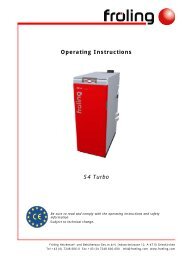Operating Instructions TURBOMAT TM 150 / 220 - Econergy Ltd
Operating Instructions TURBOMAT TM 150 / 220 - Econergy Ltd
Operating Instructions TURBOMAT TM 150 / 220 - Econergy Ltd
You also want an ePaper? Increase the reach of your titles
YUMPU automatically turns print PDFs into web optimized ePapers that Google loves.
Safety Information<br />
Five devices to counter over-heating:<br />
As a rule, the operator is not authorized to modify the safety equipment, to<br />
make substitutions, to by-pass any systems, or to change the settings.<br />
The boiler system's type and power rating also may not be modified without the<br />
concurrence of an expert.<br />
In order to avoid burn injuries, the boiler is only to be operated using the<br />
handles provided. For the same reason, you should avoid touching the flue<br />
pipes during operation.<br />
The operating door is located behind the insulating door. It can only be opened<br />
if the induced draught fan is running or starts running after the insulating door is<br />
opened.<br />
Caution: - Open the fill tank doors slowly when system is operating<br />
(explosions)<br />
If this is not the case, the temperature monitor safety device has disengaged<br />
the induced draught ventilator (See function below: "Five systems to prevent<br />
over-heating"). Opening the doors when the induced draught is not running<br />
could allow the incompletely burned gases in the boiler to escape into the boiler<br />
room, resulting in a powerful explosion!<br />
• Boiler controller: switches off the boiler if the boiler temperature is set 5°C<br />
above the set value<br />
• Temperature monitoring safety device (via control system): disengages the<br />
boiler if it reaches a temperature of 93°C, so that it can automatically reengage<br />
once the temperature drops below 89°C.<br />
• Thermal discharge safety device: opens a valve when the temperature<br />
reaches 95°C or 100°C. This valve allows cold water to flow into the boiler's<br />
safety heat-exchanger, to draw off the heat from the boiler and prevent its<br />
temperature going any higher. Using the water from the thermal discharge<br />
safety device or from the heating system as domestic hot water is absolutely<br />
forbidden.<br />
• Safety temperature limiter: disengages the induced draught when the boiler<br />
temperature reaches 100°C (the pumps continue to run). Physically unlatch<br />
the safety temperature limiter situated on the back side, as soon as the<br />
temperature has again dropped below 95°C (screw off the cap and push in the<br />
head approximately 0.5 cm using a matchstick or a small screw-driver).<br />
• Safety valve (SV): If all the previously mentioned systems fail to prevent a<br />
continuing rise in temperature, the system pressure will also rise (up to 2.5 or<br />
3 bar). If this is the case, the safety valve opens and vents off the hot water in<br />
the form of steam. If this should happen, water must be added before a new<br />
system start-up.<br />
8 B0310003 Edition 2003



